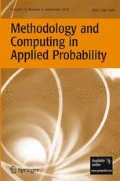Abstract
A specific function f(r) involving a ratio of complicated gamma functions depending upon a real variable r(> 0) is handled. Details are explained regarding how this function f(r) appeared naturally for our investigation with regard to its behavior when r belongs to R+. We determine explicitly where this function attains its unique minimum. In doing so, quite unexpectedly the customary Cramér-Rao inequality comes into play in order to nail down a valid proof of the required lower bound for f(r) and locating where is that lower bound exactly attained.
Similar content being viewed by others
References
Abramowitz M, Stegun I (1972) Handbook of mathematical functions, ninth printing. Dover, New York
Anscombe FJ (1952) Large-sample theory of sequential estimation. In: Proceedings of cambridge philosophical society, vol 48, pp 600–607
Anscombe FJ (1953) Sequential estimation. J Royal Stat Soc Series B 15:1–29
Carroll RJ (1977) On the asymptotic normality of stopping times based on robust estimators. Sankhyā Series A 39:355–377
Chow YS, Robbins H (1965) On the asymptotic theory of fixed width confidence intervals for the mean. Annal Math Stat 36:457–462
Cramér H (1946) A contribution to the theory of statistical estimation. Skandnavian Acturial Journal pp 85–94
Ghosh M, Mukhopadhyay N (1975) Asymptotic normality of stopping times in sequential analysis, unpublished manuscript Indian statistical institute, Calcutta, India
Ghosh M, Mukhopadhyay N (1976) On two fundamental problems of sequential estimation. Sankhyā Series B 38:203–218
Ghosh M, Mukhopadhyay N, Sen PK (1997) Sequential Estimation. Wiley, New York
Gut A, Mukhopadhyay N (2010) On asymptotic and strict monotonicity of a sharper lower bound for student’s t percentiles. Methodol Comput Appl Probab 12:647–657
Lai TL, Siegmund D (1977) A nonlinear renewal theory with applications to sequential analysis i. Annal Stat 5:946–954
Lai TL, Siegmund D (1979) A nonlinear renewal theory with applications to sequential analysis II. Annal Stat 7:60–76
Lanczos C (1964) A precision approximation of the gamma function. SIAM J Appl Math Series B Numer Anal 1:86–96
Mukhopadhyay N (1975) Sequential methods in estimation and prediction, Ph.D. dissertation, May 1975 Indian statistical institute, Calcutta, India
Mukhopadhyay N (1988) Sequential estimation problems for negative exponential populations. Commun Stat Theor Methods (Reviews Section) 17:2471–2506
Mukhopadhyay N (2000) Probability and statistical inference. Dekker, New York
Mukhopadhyay N (2010) On a new sharper lower bound for a percentile of a student’s t distribution with an application. Meth Comput Appl Prob 12:609–622
Mukhopadhyay N (2011) On sharp jensen’s inequality and some unusual applications, communications in statistics. Theor Methods 40:1283–1297
Mukhopadhyay N, Bhattacharjee D (2010) Stirling’s formula and its extensions: heuristic approaches, communications in statistics. Theor Methods 39:1046–1053
Mukhopadhyay N, Chattopadhyay B (2012) A tribute to frank anscombe and random central limit theorem from 1952. Sequent Anal 31:265–277
Mukhopadhyay N, De Silva BM (2009) Sequential methods and their applications. CRC, Boca Raton
Mukhopadhyay N, Solanky TKS (1994) Multistage selection and ranking procedures. Dekker, New York
Mukhopadhyay N, Son M (2016) Stirling’s formula for gamma functions and bounds for ratios of gamma and beta functions: a synthesis with new results. Meth Comput Appl Prob 18:1117–1127
Mukhopadhyay N, Zacks S (2018) Modified LinexTwo-stage and purely sequential estimation of the variance in a normal distribution with illustrations using horticultural data. In: Sinha BK, Sinha BK, Coelho CA, Mathew T, Mukhopadhyay N (eds) Advances in statistical planning and inference, 70th birthday festschrift for. Journal of statistical theory and practice, vol 12, pp 111–135
Mukhopadhyay N, Zhang C (2018) EDA On the asymptotic normality of the standardized sequential stopping times, part-i: parametric models. Sequent Anal 37:342–374
Pugh G (2004) An analysis of the Lanczos Gamma Approximation Ph.D thesis, department of mathematics, university of british columbia
Rao CR (1945) Information and accuracy attainable in the estimation of statistical parameters. Bull Calcutta Math Soc 37:81–91
Rao CR (1973) Linear statistical inference and its applications, 2nd edn. Wiley, New York
Ray WD (1957) Sequential confidence intervals for the mean of a normal population with unknown variance. J Royal Stat Soc Series B 10:133–143
Robbins H (1959) Sequential estimation of the mean of a normal population. In: Cramér H, Grenander U (eds) Probability and Statistics, volume. Almquist and Wiksell, Uppsala, pp 235–245
Spouge JL (1994) Computation of the gamma, digamma, and trigamma functions. SIAM J Numer Anal 31:931–944
Starr N (1966) On the asymptotic efficiency of a sequential procedure for estimating the mean. Annal Math Stat 37:1173–1185
Woodroofe M (1977) Second order approximations for sequential point and interval estimation. Annal Stat 5:984–995
Woodroofe M (1982) Nonlinear renewal theory in sequential analysis, CBMS Lecture Notes #39. SIAM, Philadelphia
Zacks S (2005) Some recent results on the distributions of stopping times of compound poisson processes with linear boundaries, inspecial issue in honor of herman chernoff. J Stat Plann Infer 130:95–109
Zacks S (2009) Stage-wise adaptive designs. Wiley, New York
Zacks S (2017) Sample path analysis and distributions of boundary crossing times, lecture notes in mathematics. Springer, New York
Zacks S, Mukhopadhyay N (2009) On exact and asymptotic properties of two-stage and sequential estimation of the normal mean under linex loss. Commun Stat Theor Meth 38:2992–3014
Acknowledgements
We are grateful to the Editor-in-Chief, the anonymous Associate Editor and two reviewers for their enthusiastic assessment.
Author information
Authors and Affiliations
Corresponding author
Additional information
Publisher’s Note
Springer Nature remains neutral with regard to jurisdictional claims in published maps and institutional affiliations.
Rights and permissions
About this article
Cite this article
Mukhopadhyay, N., Bishnoi, S.K. An Unusual Application of Cramér-Rao Inequality to Prove the Attainable Lower Bound for a Ratio of Complicated Gamma Functions. Methodol Comput Appl Probab 23, 1507–1517 (2021). https://doi.org/10.1007/s11009-020-09822-w
Received:
Revised:
Accepted:
Published:
Issue Date:
DOI: https://doi.org/10.1007/s11009-020-09822-w
Keywords
- Asymptotic distribution
- CLT
- Confidence interval
- Cramér-Rao inequality
- Gamma functions
- Point estimation
- Random CLT
- Stopping time



